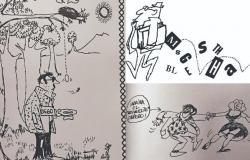The birth and marriage of Juana Koslay comprise the life span of the Indian woman that Sergio Oste portrayed in “Arocena: the last princess”, his new epic novel. For the writer, the link between the indigenous woman who lived in the fields that now bear her name and a Spanish commander represents the birth of what is known today as puntanidad.
With special emphasis on young people being interested in history, Oste proposed a book for youth reading, with historical rigor and fantastic support in similar doses. The copy was presented at the Dunken publishing house’s stand at the International Book Fair in Buenos Aires last month and this Wednesday, at 5:00 p.m., it will have its Puntano event at Librería Yenny, in Colón and Belgrano.
“It is a book that can be read by 10-year-olds and 110-year-olds,” summarized Oste, who divided his work into two chapters.
Arocena—who would later be called Juana Koslay—was the firstborn of the michilingual chief Cabeytú Koslay. Oste shows her as a restless, somewhat rebellious teenager, who had as her first pet a weasel, with which she played at night, and as her second, an owl that transmitted news from the town to her.
From so many nights she spent with the weasel, Arocena developed the ability to see in the dark—like the marsupial—, which she later used to become the sentinel of her town and to learn many of the stories of her people that happened at night.
And it was the owl, which in Oste’s book is called “Black Tears”, who gave the young woman information that the boys from her tribe who they thought were lost were actually prisoners of the Spanish, on the other side of the mountains. , where her father wouldn’t let her go.
“All that information that she received when she was a teenager made her mature and understand many things about her town,” said Oste, also author of “Dar la Voz”, “Memoria de Villa Mercedes, Caminito y la Calle Angosta” – where he theorizes that the lyrics of the tango were written in Villa Mercedes—and “Cuentos para Valentino”, a book of seven stories that reached the hands of Pope Francis.
At that point, Oste recognized that “Arocena…” is a different work from what he has published until now, since it has a secular vision, to the point that at the end, the young princess allows herself to criticize her father for the imposition of religion to native peoples.
The character of the young michilingual woman was—in Oste’s eyes—so strong that one day she decided to go to the Spanish command to ask for her detained friends. The consequences were a few days in jail, until her father negotiated her release. The price to pay for her was her marriage to Captain Gómez Isleño.
“Throughout Latin America,” the author noted, “this type of alliance occurred in which Spaniards married native women. From there the first Creoles emerged.”
For the distribution of his new novel, apart from the commercial one, Oste has an idea that includes the schools of San Luis. According to the author, establishments that want to have his book can contact him so that he can send them a physical book and provide students with a free download of his story.






